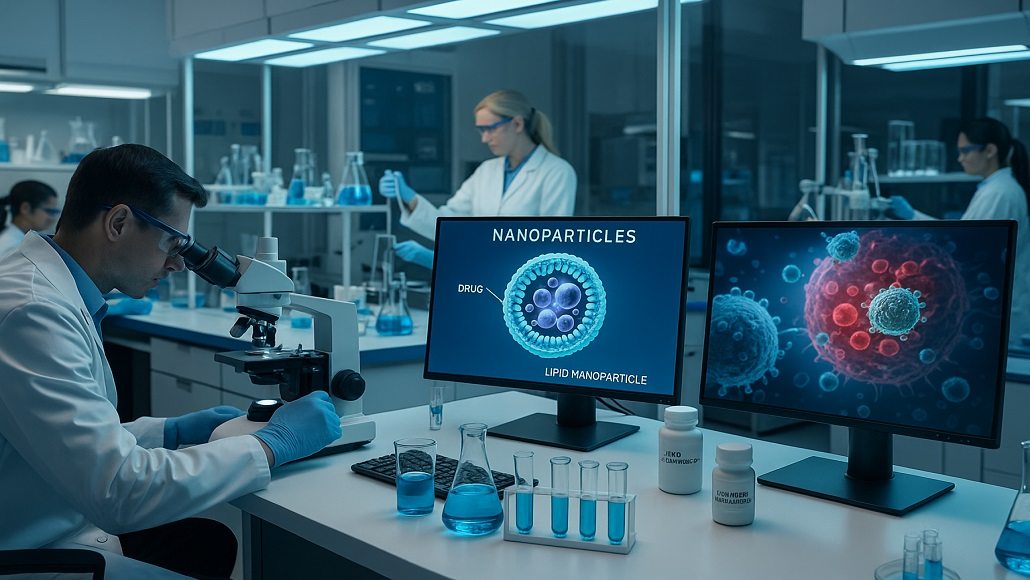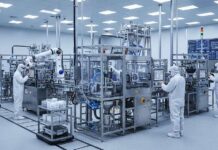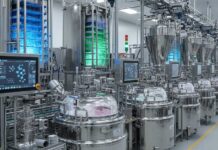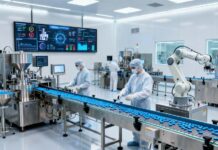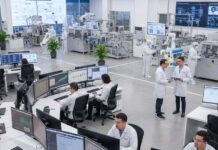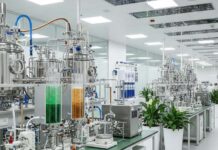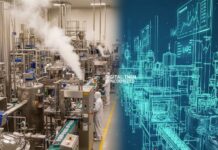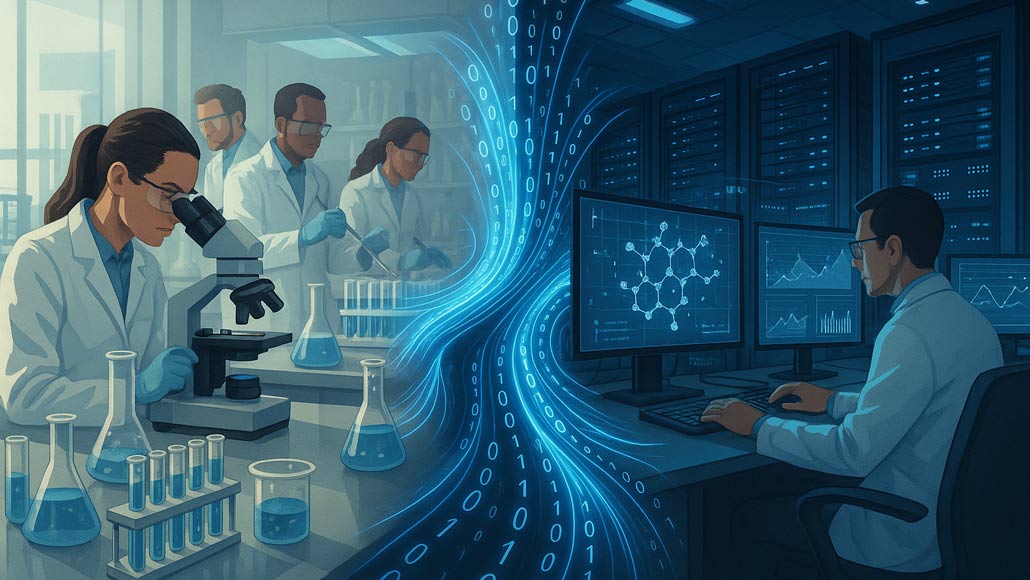Bridging Wet Lab and Dry Lab Workflows with Generative AI Tools
The traditional division between computational “dry lab” research and experimental “wet lab” activities has long characterized pharmaceutical research, often creating silos that limit scientific collaboration and slow discovery progress. However, the emergence of generative artificial intelligence is fundamentally transforming this landscape by creating seamless bridges between computational analysis and experimental validation. This technological convergence enables unprecedented integration of theoretical modeling with practical experimentation, resulting in more efficient research workflows, accelerated discovery timelines, and improved translation of computational insights into therapeutic applications.
The Historical Divide Between Computational and Experimental Research
Traditional pharmaceutical research organizations have historically operated with distinct computational and experimental divisions, each employing different methodologies, timelines, and success metrics. Computational researchers typically focus on modeling, simulation, and data analysis activities that can be performed using computer systems, while experimental scientists concentrate on laboratory-based activities including synthesis, biological testing, and analytical characterization.
This organizational structure, while logical from a resource management perspective, often creates communication barriers that limit the potential for synergistic research approaches. Computational predictions may not effectively inform experimental design decisions, while experimental results may not be systematically fed back into computational models for continuous improvement. The result is often suboptimal resource utilization and missed opportunities for breakthrough discoveries that require close integration of theoretical and experimental approaches.
Wet lab vs dry lab AI represents a fundamental shift away from these traditional divisions toward integrated research environments where computational and experimental activities are seamlessly coordinated through intelligent systems. This integration enables real-time collaboration between computational and experimental researchers while ensuring that theoretical insights directly inform experimental strategies.
The technological barriers that have historically separated computational and experimental research are being systematically addressed through AI platforms that can translate between different research modalities, coordinate complex workflows, and enable effective communication between researchers with different technical backgrounds.
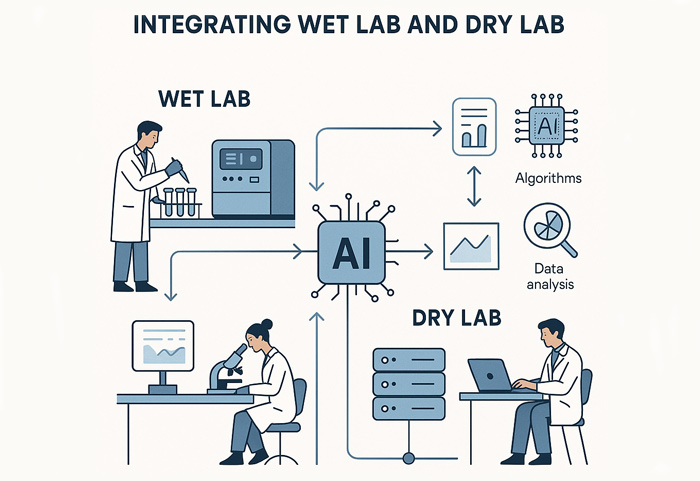
AI-Enabled Workflow Integration Strategies
Modern generative AI systems excel at creating integrated workflows that seamlessly combine computational prediction with experimental validation, enabling research approaches that leverage the strengths of both methodologies. These integrated systems can automatically translate computational predictions into experimental protocols, coordinate resource allocation across different research activities, and ensure that experimental results inform subsequent computational analyses.
The integration process begins with AI systems that can analyze computational models and identify experimental validation requirements. These systems can recommend specific experiments needed to test computational predictions, estimate resource requirements for validation studies, and predict the likelihood of experimental success based on model confidence levels and historical validation data.
Automated protocol generation represents a key capability where AI systems translate computational insights into specific experimental procedures. For instance, molecular dynamics simulations predicting optimal binding conformations can be automatically translated into specific synthesis targets, purification protocols, and biological assay conditions needed for experimental validation.
Real-time feedback mechanisms enable experimental results to immediately inform computational model updates and refinements. This closed-loop approach ensures that computational models remain aligned with experimental reality while enabling continuous improvement of predictive capabilities based on actual research outcomes.
Resource optimization becomes more sophisticated when AI systems can coordinate computational and experimental activities to minimize bottlenecks and maximize overall research productivity. These systems can predict when experimental validation will be needed, schedule computational analyses to support experimental timelines, and optimize laboratory resource allocation based on computational priorities.
Enhancing Experimental Design Through Computational Insights
One of the most significant benefits of AI-integrated research workflows lies in the ability to leverage computational insights to optimize experimental design strategies. Traditional experimental approaches often rely on established protocols and researcher intuition, potentially missing optimal conditions that could improve experimental outcomes or reduce resource requirements.
AI systems can analyze computational predictions to identify critical experimental parameters that are most likely to influence outcomes. This predictive capability enables researchers to focus their experimental efforts on conditions most likely to yield meaningful results while avoiding experimental approaches that computational analysis suggests are unlikely to succeed.
The technology enables sophisticated experimental optimization where multiple variables can be simultaneously optimized based on computational predictions and experimental constraints. For example, AI systems can recommend optimal pH conditions, buffer compositions, temperature profiles, and timing parameters based on molecular dynamics simulations while accounting for practical experimental limitations.
Predictive experimental failure analysis helps researchers identify potential problems before experiments begin, enabling proactive mitigation strategies that reduce the likelihood of experimental failures. This predictive capability is particularly valuable for expensive or time-sensitive experiments where failure represents significant resource waste.
Statistical experimental design becomes more powerful when informed by computational confidence intervals and uncertainty quantification. AI systems can recommend sample sizes, statistical approaches, and validation strategies based on computational model predictions and their associated uncertainty levels.
Accelerating Discovery Through Predictive Modeling
The integration of generative AI with experimental workflows dramatically accelerates discovery timelines by enabling researchers to prioritize experimental efforts based on computational predictions of success probability and potential impact. This predictive approach enables more strategic allocation of research resources while reducing the time required to achieve meaningful research outcomes.
Machine learning models trained on historical research data can predict which experimental approaches are most likely to yield breakthrough discoveries, enabling research organizations to focus their efforts on high-impact opportunities. These prediction capabilities are particularly valuable for pharmaceutical companies seeking to optimize their research portfolios and maximize return on investment.
The technology enables rapid hypothesis testing where computational models generate testable predictions that can be quickly validated through targeted experiments. This iterative approach accelerates the scientific discovery process while ensuring that computational insights are properly validated through experimental evidence.
Virtual screening capabilities enhanced by experimental feedback enable more efficient identification of promising research directions. AI systems can screen vast computational libraries while prioritizing compounds or conditions that are most amenable to experimental validation and most likely to yield positive results.
Real-Time Data Integration and Analysis
Modern AI-integrated research platforms excel at real-time data integration that ensures computational models remain current with the latest experimental results while enabling immediate analysis of new data as it becomes available. This real-time capability eliminates traditional delays between experimental data generation and computational analysis, enabling faster research cycles and more responsive research strategies.
Automated data preprocessing ensures that experimental results are immediately formatted and quality-controlled for computational analysis. This automation eliminates manual data handling steps that can introduce errors and delays while ensuring consistent data quality across different experimental platforms and research programs.
The technology enables streaming analysis where computational models are continuously updated as new experimental data becomes available. This dynamic approach ensures that research insights remain current while enabling real-time optimization of ongoing experimental programs based on accumulating evidence.
Cross-platform data integration capabilities ensure that results from different experimental techniques, computational methods, and research programs can be effectively combined to generate comprehensive insights. This integration is particularly valuable for complex research programs that require multiple complementary approaches to address research objectives.
Optimizing Resource Allocation and Laboratory Management
Wet lab vs dry lab AI integration significantly improves resource allocation decisions by enabling comprehensive analysis of research needs across both computational and experimental domains. Traditional resource planning often treats these domains separately, potentially leading to suboptimal allocation decisions that create bottlenecks or underutilize available capabilities.
Predictive resource planning enables research organizations to forecast future computational and experimental needs based on research pipelines, project timelines, and expected outcomes. This predictive capability supports more strategic investment decisions while ensuring that adequate resources are available to support integrated research approaches.
Laboratory scheduling optimization becomes more sophisticated when AI systems can coordinate experimental activities with computational analyses to minimize delays and maximize equipment utilization. These systems can predict when computational results will be available to inform experimental design and schedule laboratory resources accordingly.
Equipment utilization optimization ensures that expensive laboratory instrumentation is used efficiently while computational resources are allocated to support experimental priorities. This optimization is particularly important for research organizations with limited access to specialized equipment or computational infrastructure.
The technology enables dynamic resource reallocation where research priorities can be adjusted in real-time based on emerging results and changing research landscapes. This flexibility ensures that resources are continuously optimized to support the most promising research opportunities while maintaining adequate support for ongoing programs.
Collaborative Research and Knowledge Sharing
AI-integrated research platforms facilitate collaboration between computational and experimental researchers by providing common interfaces, shared data standards, and coordinated workflow management systems. These collaborative capabilities enable research teams to work more effectively across traditional disciplinary boundaries while ensuring that all team members have access to relevant information and analysis capabilities.
Knowledge sharing becomes more systematic when AI systems can automatically capture research insights, experimental protocols, and computational methods in standardized formats that can be easily shared across different research programs. This systematic documentation improves research reproducibility while enabling more effective knowledge transfer between projects and research teams.
The technology enables collaborative experimental design where computational and experimental researchers can jointly optimize research strategies based on their complementary expertise. AI systems can facilitate these collaborations by translating between different technical vocabularies and ensuring that all stakeholders understand the implications of different research decisions.
Cross-functional training becomes more effective when AI systems can provide personalized learning recommendations that help computational researchers understand experimental constraints and enable experimental scientists to effectively utilize computational insights. This training capability is essential for building research teams that can effectively leverage integrated research approaches.
Quality Control and Validation Strategies
Integrated research workflows require sophisticated quality control mechanisms that ensure both computational predictions and experimental results meet appropriate standards for scientific validity and regulatory compliance. AI systems can automate many quality control processes while providing comprehensive validation strategies that account for both computational and experimental uncertainties.
Computational model validation becomes more rigorous when continuously informed by experimental results that test model predictions across diverse conditions and applications. This ongoing validation process ensures that computational models remain accurate and reliable while identifying areas where model improvements are needed.
Experimental validation of computational predictions requires systematic approaches that account for model uncertainty and ensure appropriate statistical power for validation studies. AI systems can optimize these validation strategies while ensuring that experimental resources are used efficiently to provide maximum validation value.
Cross-validation between different computational methods and experimental approaches provides additional confidence in research results while identifying potential systematic errors or biases. This comprehensive validation approach is particularly important for research results that will inform therapeutic development decisions or regulatory submissions.
Regulatory Compliance and Documentation
The integration of computational and experimental research workflows requires careful attention to regulatory requirements that govern both domains while ensuring comprehensive documentation that supports regulatory review processes. AI systems can automate much of this documentation while ensuring compliance with relevant guidelines and standards.
Traceability requirements demand comprehensive tracking of how computational predictions inform experimental design decisions and how experimental results influence computational model updates. This bidirectional traceability is essential for regulatory compliance and scientific reproducibility.
Validation documentation must demonstrate that integrated research workflows meet appropriate standards for both computational modeling and experimental research. This documentation includes algorithm validation, experimental protocol validation, and demonstration that integrated approaches provide reliable and reproducible results.
Quality assurance protocols ensure that integrated research systems maintain consistent performance over time while continuing to meet regulatory requirements as research programs evolve and expand. Regular auditing, performance monitoring, and system updates ensure ongoing compliance and reliability.
Future Directions and Emerging Technologies
The future of integrated computational-experimental research involves increasingly sophisticated AI systems that can handle more complex research challenges while providing deeper insights into biological and chemical systems. Emerging technologies including quantum computing, advanced robotics, and enhanced machine learning algorithms promise to expand integration capabilities while addressing current limitations.
Autonomous research systems represent a future direction where AI systems can independently design experiments, execute computational analyses, and validate results with minimal human intervention. These autonomous capabilities may revolutionize pharmaceutical research by enabling continuous research progress while reducing human resource requirements.
Virtual reality and augmented reality technologies may enhance collaboration between computational and experimental researchers by providing immersive interfaces that enable more intuitive interaction with complex data and research systems. These technologies may improve communication and decision-making across disciplinary boundaries.
Cloud-based research platforms will enable more extensive collaboration while providing access to advanced computational and experimental resources that may not be available within individual research organizations. These platforms may democratize access to cutting-edge research capabilities while enabling more effective resource sharing across the research community.
Conclusion
The integration of computational and experimental research through generative AI represents a fundamental transformation in how pharmaceutical research is conducted. By bridging traditional divides between wet lab vs dry lab AI approaches, these integrated systems enable more efficient, more effective, and more innovative research strategies that accelerate discovery while improving research quality.
The successful implementation of integrated research workflows requires careful attention to technical integration challenges, regulatory compliance requirements, and organizational change management considerations. Research organizations that successfully navigate these challenges will gain significant competitive advantages through faster discovery timelines, improved success rates, and more comprehensive understanding of complex biological systems.
The future of pharmaceutical research lies in seamless collaboration between computational prediction and experimental validation, enabled by AI systems that maximize the synergistic potential of these complementary approaches. Organizations that embrace this integrated vision will be better positioned to address complex healthcare challenges while developing innovative therapeutic solutions that improve human health.





